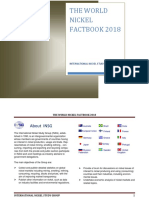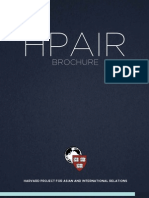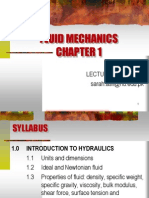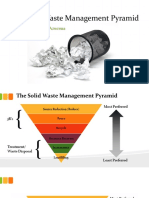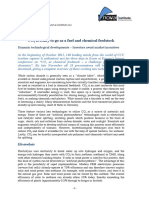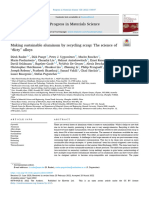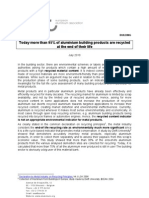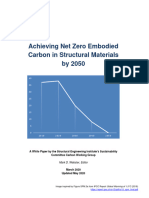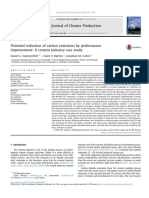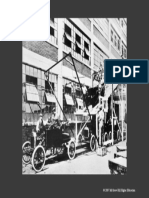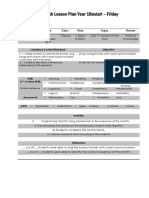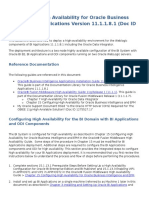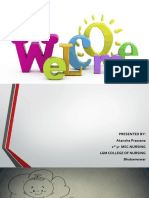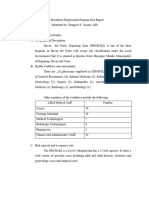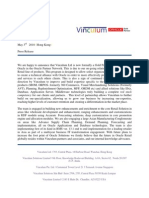0 ratings0% found this document useful (0 votes)
126 viewsJulian Allwood Sustainable Materials With Both Eyes Open SoSL12 Low
Julian Allwood Sustainable Materials With Both Eyes Open SoSL12 Low
Uploaded by
beccafabbri1) Dr. Julian Allwood argues that token gestures aimed at sustainability, like banning plastic grocery bags, make little impact and we need scalable solutions. 2) Allwood's research found that 64% of global CO2 emissions come from industry, buildings, and transport, with the top 5 materials (steel, cement, paper, plastic, aluminum) accounting for 55% of industrial emissions. 3) Allwood proposes a "Material Manifesto" with 6 actions including using less metal through design optimization, reducing yield losses in production, and reusing components before recycling to cut emissions in key industries by up to 30%.
Copyright:
© All Rights Reserved
Available Formats
Download as PDF, TXT or read online from Scribd
Julian Allwood Sustainable Materials With Both Eyes Open SoSL12 Low
Julian Allwood Sustainable Materials With Both Eyes Open SoSL12 Low
Uploaded by
beccafabbri0 ratings0% found this document useful (0 votes)
126 views3 pages1) Dr. Julian Allwood argues that token gestures aimed at sustainability, like banning plastic grocery bags, make little impact and we need scalable solutions. 2) Allwood's research found that 64% of global CO2 emissions come from industry, buildings, and transport, with the top 5 materials (steel, cement, paper, plastic, aluminum) accounting for 55% of industrial emissions. 3) Allwood proposes a "Material Manifesto" with 6 actions including using less metal through design optimization, reducing yield losses in production, and reusing components before recycling to cut emissions in key industries by up to 30%.
Original Description:
Julian Allwood
Copyright
© © All Rights Reserved
Available Formats
PDF, TXT or read online from Scribd
Share this document
Did you find this document useful?
Is this content inappropriate?
1) Dr. Julian Allwood argues that token gestures aimed at sustainability, like banning plastic grocery bags, make little impact and we need scalable solutions. 2) Allwood's research found that 64% of global CO2 emissions come from industry, buildings, and transport, with the top 5 materials (steel, cement, paper, plastic, aluminum) accounting for 55% of industrial emissions. 3) Allwood proposes a "Material Manifesto" with 6 actions including using less metal through design optimization, reducing yield losses in production, and reusing components before recycling to cut emissions in key industries by up to 30%.
Copyright:
© All Rights Reserved
Available Formats
Download as PDF, TXT or read online from Scribd
Download as pdf or txt
0 ratings0% found this document useful (0 votes)
126 views3 pagesJulian Allwood Sustainable Materials With Both Eyes Open SoSL12 Low
Julian Allwood Sustainable Materials With Both Eyes Open SoSL12 Low
Uploaded by
beccafabbri1) Dr. Julian Allwood argues that token gestures aimed at sustainability, like banning plastic grocery bags, make little impact and we need scalable solutions. 2) Allwood's research found that 64% of global CO2 emissions come from industry, buildings, and transport, with the top 5 materials (steel, cement, paper, plastic, aluminum) accounting for 55% of industrial emissions. 3) Allwood proposes a "Material Manifesto" with 6 actions including using less metal through design optimization, reducing yield losses in production, and reusing components before recycling to cut emissions in key industries by up to 30%.
Copyright:
© All Rights Reserved
Available Formats
Download as PDF, TXT or read online from Scribd
Download as pdf or txt
You are on page 1of 3
Sustainable materials
with both eyes open
Dr Julian Allwood
> Back to Investigating the Future > Back to Contents
Domestic Disaster 3: Planet Earth
by the artist duo HeHe recreates a
miniaturised polluted atmosphere
placed on a world map
THE FUTURE IN PRACTICE
THE STATE OF SUSTAINABILITY LEADERSHIP
Sustainable materials
with both eyes open
Dr Julian Allwood
Dr Julian Allwood is a University Reader
in the Department of Engineering,
and leader of the Low Carbon Materials
Processing Group. He is co-author of
Sustainable Materials With Both Eyes
Open (2011). Interview by Wayne Visser.
Allwood believes that we need to face the facts
and nd scalable solutions, rather than token
gestures that make very little impact. In the
opening chapter of his new book, Sustainable
Materials, Allwood cites plastic grocery bags in
the UK as a case in point. He notes that plastic
accounts for about 1 per cent of the UKs CO
2
emissions, and plastic carrier bags make up
1 per cent of plastic use. Hence, even if all
plastic bags were scrapped and assuming
their substitute were carbon neutral, which
is unlikely we would only be addressing
0.01 per cent of the UKs carbon footprint.
By contrast, says Allwood, our aim is to look
for solutions, and our number-one guiding
principle is about scale we want to make
sure that we identify options for change that
are big enough to make a big dierence.
Allwoods research team starts by quantifying
which economic activities generate the most
emissions. It turns out that 64 per cent of
global CO
2
emissions are energy- or process-
related (the rest are from deforestation,
agriculture or decay); and 35 per cent of these
emissions are from industry, 31 per cent from
buildings and 27 per cent from transport.
In terms of buildings and transport, Allwood
believes that there are still signicant gains
to be made from improved designs and
The Future in Practice: The State of Sustainability Leadership
The Intergovernmental Panel on Climate Change
(IPCC) estimates that global greenhouse gas
reductions of 5085 per cent will be needed
by 2050 to avoid dangerous climate change,
representing a radical shift away from todays
fossil-fuel-derived economy.
1
This begs the
question: is such a reduction achievable, and if
so, how? This is one of the key challenges tackled
through the research of Dr Julian Allwood and his
Low Carbon Materials Processing Group (LCMPG)
at the University of Cambridge.
1
Keeping the concentration of CO
2
equivalents in the atmosphere between 445490 parts per million with a corresponding average global
temperature increase of between 2.0C and 2.4C
technologies perhaps as much as 75 per
cent in energy savings. This is especially true
for passive systems which provide more nal
services for each unit of useful energy. He
concludes that technical solutions for energy-
ecient cars and houses are known, and
their implementation depends on political
will and public motivation. The same is
not true, however, for industrial emissions,
where many systems are already highly
optimised, and where demand for materials
is anticipated to double in the next 40 years.
For most materials used to provide buildings,
infrastructure, equipment and products, global
stocks are still sucient to meet anticipated
demand; but the environmental impacts
of materials production and processing,
particularly those related to energy, are
rapidly becoming critical. In this case, it is
not energy eciency, but rather material
eciency that represents the biggest
opportunity. Material eciency which
essentially means delivering the same
required services with less primary production
could allow greater cuts, at lower cost.
Here, too, it is important to focus on the
biggest sources of impact, namely the ve
materials that contribute 55 per cent of global
CO
2
emissions from industry and 20 per cent
of global CO
2
emissions from energy use and
industrial processes. Allwoods LCMP Group
has predicted emissions scenarios to 2050
for ve materials: steel, cement, paper, plastic
and aluminium. Specically, in their Reference
scenario which includes implementing
all known and emerging best available
technologies globally, raising recycling to
the maximum possible, and securing 20 per
cent decarbonisation of all energy industry
still fails to deliver the minimum 50 per
cent emission cuts required by the IPCC.
Based on an analysis of strategies to improve
material eciency in these ve key materials,
Allwoods LCMP Group have created a
Material Manifesto, which includes the
following six actions to make the future
of materials use more sustainable.
1. Use less metal by design
We could make big savings by optimising the
design of metal components. The materials
used by industry are often designed in a
regular shape to make production easier and
more ecient. But this means that they often
use more material than they have to. The
researchers calculate that if we can optimise
beam designs, for example, to suit their use,
we could make weight savings of up to 30 per
cent with a similar reduction in the emissions
caused by production. Similar techniques could
be applied to the production of components
for cars, the rebar used to reinforce
concrete, and steel cans for food storage.
Figure 1: Sources of global CO
2
emissions. from Sustainable Materials With Both Eyes Open.
Figure 2: Normalised global demand for the ve key materials since 1960,
from Allwood et al, Environmental Science & Technology 2010, 44, 18881894.
Continued... > Back to Investigating the Future > Back to Contents
2. Reduce yield losses
At least 25 per cent of liquid steel and 40
per cent of liquid aluminium never makes it
into products. Instead, it is cut o as scrap in
manufacturing. One extreme example is the
aluminium wing skin used for aeroplanes:
90 per cent of the metal produced in this
process ends up as swarf, or aluminium scrap.
The researchers found that this is often the
result of habit, rather than necessity. Clothing
manufacturers have, for example, actually
derived the algorithms needed to make sure
that rolls of fabric are used to maximum eect.
Manufacturers could do the same thing with
the metal they receive. The team calculated
that reducing yield losses through this and
other techniques would cut CO
2
emissions
by about 16 per cent in the steel industry
and 7 per cent in the aluminium industry.
3. Divert manufacturing scrap
Scrap metal is usually sent for recycling,
which means melting it (an energy-intensive
process). In fact, it could just be used
elsewhere. For example, most steel scrap
comes from blanking skeletons the remains
of sheets of steel after shapes have been cut
out of them. About 60 megatons of steel are
scrapped on this basis every year. We could
eectively reduce scrap steel by half if these
skeletons went to the manufacturers of smaller
components instead, who can use whats left.
4. Re-use old components
before recycling at all
Old components are often recycled when
they could be re-used directly instead.
Car dismantlers are an example of good
practice, breaking up damaged or old
vehicles and re-using the components. But
steel in construction remains the biggest
potential asset, and although the beams from
dismantled buildings are usually recycled,
they could often be used again straight away
instead. When you take a building down,
the steel girder is totally reusable, Allwood
says. All you need to do is unbolt it and clean
it, because steel doesnt degrade with use.
Re-use means we can avoid all the energy of
melting, casting and re-rolling old steel.
5. Extend the lives of products
Most demand for products in developed
economies isnt to expand the overall stock, but
to replace existing items. Fridges are a good
example we still need them but in the UK we
destroy 33 per cent more fridges every year
than we make cars. The researchers advocate
Figure 3: Predicted 2050 emissions for the ve key materials under various future strategies. The blue bar
shows how extensively the strategy must be implemented to reach the IPCC target. If 100 per cent implementation is
insucient, the red bar shows the excess emissions relative to the target.
Strategies Steel Cement Plastic Paper Aluminium
Reference: all known and emerging best available technologies
implemented globally, raise recycling to maximum possible and
20% decarbonisation of all energy
As Reference, but with carbon sequestration applied to primary
production
As Reference, but with non-destructive recycling
As Reference, but with demand reduced through light-weighting,
substitution and extending product lives
As Reference with novel process technologies using less
energy and creating less scrap
100%
100%
100%
100%
100%
50%
50%
50%
50%
50%
0%
0%
0%
0%
0%
When you take a building down, the steel girder is
totally reusable. All you need to do is unbolt it and
clean it, because steel doesnt degrade with use.
Allwood, JM and Cullen, J, 2012. Sustainable
Materials With Both Eyes Open. Cambridge:
UIT Cambridge. Free download from www.
withbotheyesopen.com
Allwood, JM, Ashby, MF, Gutowski, TG and Worrel, E,
2011. Material eciency: a white paper. Resources,
Conservation and Recycling 55 (2011) pp.362381
Allwood, JM, Cullen, JM and Milford, RL, 2010.
Options for Achieving a 50% Cut in Industrial
Carbon Emissions by 2050. Environmental Science
and Technology 44, (2010) pp.18881894
Cambridge Research News, 2011. Six steps to a
better material world. 30 November. http://www.
cam.ac.uk/research/news/six-steps-to-a-better-
material-world/
The artist duo HeHe, formed by Helen Evens and Heiko Hansen, create with Domestic Disaster 3: Planet Earth (2012)
an unsettling installation, full of beauty and menace. Colourful and articial, animated by a slow movement and
accompanied by a sound choreography, this atmosphere echoes the research on uid dynamics led by Jean-Marc
Chomaz (CNRS, Laboratoire LadHyX, France). The work was commissioned for the Cape Farewell exhibition Carbon
12: Art and Climate Change. CPSL is proud to be collaborating with Cape Farewell, which works with artists and
scientists on a cultural response to climate change. www.capefarewell.com
modifying products rather than replacing
them wholesale, and urging manufacturers
to develop adaptable designs that would
help this process. This requires a change in
thinking and an end to planned obsolescence.
6. Reduce nal demand
The fall-back option that no policymaker
would ever condone, except in times of war, is
to reduce nal demand. Yet it remains the case
that we could be living with less stu overall. In
the UK, for example, we each spend 225 hours
per year in the car. We have 28 million licensed
cars with, on average, four seats in each. There
are 60 million people. So each car seat is, on
average, in use for 2 per cent of the year. We
could reduce our overall stock to 7 million
cars with ease. This is, of course, scuppered by
the convenience factor of having a car when
we need it. We may not want to make these
changes to our convenient lifestyles, but that is
not to say that we couldnt do it if we needed to.
In industrialised nations, material eciency
strategies have had little attention, mainly
because of economic, regulatory and social
barriers. However, evidence from waste
management and the pursuit of energy
eciency suggests that these barriers
might be overcome. Critically, however,
dierent strategies are not equally eective
for dierent materials. For instance, non-
destructive recycling may have the most
potential for steel and paper, while novel
process technologies may be more appropriate
for plastics. In general, reducing demand
through light-weighting, substitution and
extending product life appears to be a strong
strategic option across the ve materials.
Reecting on his groups ambitious research
programme, which resulted in the publication
of Sustainable Materials, Allwood concludes:
We wanted to consider whether we could
cut emissions by reducing the amount of stu
produced in the rst place. Every aspect of our
lives today depends on materials like steel and
aluminium. If we want a sustainable future,
we need to reduce the impact of producing
them, and our biggest option for achieving
this is to reduce our thirst for new material.
> Next Article > Back to Investigating the Future > Back to Contents Download PDF of this article
>
>
The State of Sustainability Leadership is CPSLs annual thought leadership report, delivering insight
and challenge from our world-wide network of business leaders, policymakers and academic experts.
This years edition, to be published in full in December 2012, is focused on the theme of business and
the long-term what leaders can do to understand and shape the future. CPSL is an institution within
the University of Cambridges School of Technology. www.cpsl.cam.ac.uk
You might also like
- SevenRooms VMS (Dining)Document20 pagesSevenRooms VMS (Dining)Charlotte's WangNo ratings yet
- The World Nickel Factbook 2018 PDFDocument52 pagesThe World Nickel Factbook 2018 PDFMuhammad Agung RiyadiNo ratings yet
- Las Meninas en CómicDocument2 pagesLas Meninas en CómicPatricia LANo ratings yet
- Methodology CO2-Tool Electricity Gas and Heat From Biomass - Version 1Document47 pagesMethodology CO2-Tool Electricity Gas and Heat From Biomass - Version 1Biswa Jyoti GuptaNo ratings yet
- Reclaimed Building Products GuideDocument80 pagesReclaimed Building Products GuidemymalvernNo ratings yet
- DiscipleCourse NotesDocument8 pagesDiscipleCourse NotesNashvinNo ratings yet
- D3223.22337 - Standard Test Method For Total Mercury in WaterDocument8 pagesD3223.22337 - Standard Test Method For Total Mercury in WaterIngrid Mora100% (1)
- Preyesh - Design For Environmental and Substainable DesignDocument18 pagesPreyesh - Design For Environmental and Substainable DesignSHYAM SUNDARNo ratings yet
- Arnoldus Nota ENG Jan Feb 2022Document31 pagesArnoldus Nota ENG Jan Feb 2022cinta blackNo ratings yet
- Brochure 2012Document23 pagesBrochure 2012lavrock32100% (1)
- The Story of Mankind by Hendrik Van LoonDocument562 pagesThe Story of Mankind by Hendrik Van LoonbeethovenjeanNo ratings yet
- Ecodesign Manual Noruego (En Ingles - Circa 1999)Document181 pagesEcodesign Manual Noruego (En Ingles - Circa 1999)gcanale_2No ratings yet
- Smart PackagingDocument30 pagesSmart PackagingRamasubramanian SankaranarayananNo ratings yet
- Children Learing Mathematics ReadingsDocument172 pagesChildren Learing Mathematics ReadingsPerry SinNo ratings yet
- Guidelines For Designing For Disassembly and RecyclingDocument10 pagesGuidelines For Designing For Disassembly and RecyclingOzzyNo ratings yet
- CST Design Studio - WorkflowDocument102 pagesCST Design Studio - WorkflowNurSalahuddinNo ratings yet
- It Cad CamDocument26 pagesIt Cad CamsandhyaaryaNo ratings yet
- Products and Using "Greener" Processes. Many Companies Have Found It Advantageous To Explore WaysDocument8 pagesProducts and Using "Greener" Processes. Many Companies Have Found It Advantageous To Explore Wayskrrish1410No ratings yet
- CDM - Unfccc.int Methodologies Documentation Meth BookletDocument239 pagesCDM - Unfccc.int Methodologies Documentation Meth BookletDouglas Sidrim de FigueiredoNo ratings yet
- Green Engineering: Create, Enhance and SustainDocument22 pagesGreen Engineering: Create, Enhance and Sustainnandan akNo ratings yet
- Simapro ExerciseDocument2 pagesSimapro Exerciseburty1No ratings yet
- Eco Design ManualDocument4 pagesEco Design Manualacampos2012No ratings yet
- Etidorhpaorendof 00 LloyDocument418 pagesEtidorhpaorendof 00 LloyLeonardo Di Lascio ColocciniNo ratings yet
- Chapter 1 Fluid MechanicsDocument49 pagesChapter 1 Fluid MechanicsHunain AK100% (1)
- Solid Waste Management PyramidDocument43 pagesSolid Waste Management PyramidLeandrow BacolodNo ratings yet
- Comic X Penthouse n4 PDF by Doberman WWW Cantabriatorrent NetDocument2 pagesComic X Penthouse n4 PDF by Doberman WWW Cantabriatorrent NetCory0% (1)
- NEWater - Singapore's Experience in Water Reuse v1 - SNR PE Ong Key WeeDocument45 pagesNEWater - Singapore's Experience in Water Reuse v1 - SNR PE Ong Key WeeEra Reina Marie CubangayNo ratings yet
- Julian Allwood - "Sustainable Materials With Both Eyes Open"Document3 pagesJulian Allwood - "Sustainable Materials With Both Eyes Open"thedycrisNo ratings yet
- DownloadDocument10 pagesDownloadFirmansyah LatifNo ratings yet
- Economia CircularDocument35 pagesEconomia CircularMurilo Barros AlvesNo ratings yet
- Material Economics Circular EconomyDocument176 pagesMaterial Economics Circular EconomyKOPI ROBUSTA OFFICIALNo ratings yet
- Joseph Crapo Assessing The Environmental Impact of Glass Production and The Value of Optimization and RecyclingDocument8 pagesJoseph Crapo Assessing The Environmental Impact of Glass Production and The Value of Optimization and RecyclingJoe CrapoNo ratings yet
- Sustainability Assessment in the Steel Industry Using Partial Least Squares - Structural Equation ModelDocument12 pagesSustainability Assessment in the Steel Industry Using Partial Least Squares - Structural Equation ModelNapoleon FeliciaNo ratings yet
- Achieving Net ZeroDocument39 pagesAchieving Net ZeroPARAS TANEJANo ratings yet
- Broadbent2016 Article SteelSRecyclabilityDemonstratiDocument8 pagesBroadbent2016 Article SteelSRecyclabilityDemonstratimichaelNo ratings yet
- Aluminium Environment and SocietyDocument56 pagesAluminium Environment and SocietyRomi Buana Puja PangestuNo ratings yet
- What Is Carbon Foot Print?Document5 pagesWhat Is Carbon Foot Print?mnagasandeepNo ratings yet
- 1637146028kn06 Large Scale Green Hydrogen Production To Help Decarbonizing The Aluminium Sector pdf1637146028Document3 pages1637146028kn06 Large Scale Green Hydrogen Production To Help Decarbonizing The Aluminium Sector pdf1637146028Senthilkumar PragasamNo ratings yet
- What Is Green Concrete PDFDocument3 pagesWhat Is Green Concrete PDFVelchuri SairamNo ratings yet
- Final Denkstatt Report (Vers 1 3) September 2010Document45 pagesFinal Denkstatt Report (Vers 1 3) September 2010Yesid Nieto MuñozNo ratings yet
- Renewables-Based Decarbonization and Relocation of IronDocument13 pagesRenewables-Based Decarbonization and Relocation of IronIsidoro VeraNo ratings yet
- Ana-Elena Nistor, 1465352 Tutor: Alex Robinson Course: Chemical Engineering Beng H800Document6 pagesAna-Elena Nistor, 1465352 Tutor: Alex Robinson Course: Chemical Engineering Beng H800Ana ElenaNo ratings yet
- Bio-Based Engineering Plastics A Tool To Reduce Carbon FootprintDocument4 pagesBio-Based Engineering Plastics A Tool To Reduce Carbon FootprintSteve JenkinsNo ratings yet
- Dok 3Document5 pagesDok 3michele nikeNo ratings yet
- CO Is Ready To Go As A Fuel and Chemical FeedstockDocument6 pagesCO Is Ready To Go As A Fuel and Chemical FeedstockYahya IsiedNo ratings yet
- Making Sustainable Aluminum by Recycling Scrap The Science of Dirty AlloysDocument150 pagesMaking Sustainable Aluminum by Recycling Scrap The Science of Dirty Alloyswinner sembiringNo ratings yet
- !) '?III ./"+ ! 2) 6 - ?IIV 7) + ": 7Kh5Hgxfwlrqri Uhhqkrxvh DV (Plvvlrqviurpwkh&Hphqw, Qgxvwu/ BHJDocument8 pages!) '?III ./"+ ! 2) 6 - ?IIV 7) + ": 7Kh5Hgxfwlrqri Uhhqkrxvh DV (Plvvlrqviurpwkh&Hphqw, Qgxvwu/ BHJGaurav UppalNo ratings yet
- Life Cycle Analysis of A Solar Module Recycling ProcessDocument3 pagesLife Cycle Analysis of A Solar Module Recycling ProcessEva VictoriaNo ratings yet
- EAA AlurecyclinginBuildingDocument2 pagesEAA AlurecyclinginBuildingfaraz81No ratings yet
- Clean Ironmaking and Steelmaking Processes: Efficient Technologies for Greenhouse Emissions AbatementFrom EverandClean Ironmaking and Steelmaking Processes: Efficient Technologies for Greenhouse Emissions AbatementNo ratings yet
- How To Get To Zero 200525Document41 pagesHow To Get To Zero 200525zaidiamna9No ratings yet
- Shsce Term PaperDocument22 pagesShsce Term PaperHarshita SainiNo ratings yet
- Acoustic Thermal GuideDocument67 pagesAcoustic Thermal GuideRadu GalNo ratings yet
- 27potential Reduction of Carbon Emissions by Performance ImprovementDocument13 pages27potential Reduction of Carbon Emissions by Performance ImprovementzeeNo ratings yet
- Aluminium and Challenges For SustainabilityDocument4 pagesAluminium and Challenges For SustainabilityNarasimharaghavanPuliyurKrishnaswamyNo ratings yet
- Energies 13 02753Document18 pagesEnergies 13 02753Abdelkader SouiahNo ratings yet
- Assessment of The Environmental Impact of Household AppliancesDocument7 pagesAssessment of The Environmental Impact of Household AppliancesPassmore DubeNo ratings yet
- 01 - Plastics-Article CHEManager 12122018 - ENDocument5 pages01 - Plastics-Article CHEManager 12122018 - ENSandeep ChatterjeeNo ratings yet
- Slide 1Document3 pagesSlide 1wanasinghebhagya20No ratings yet
- Recycling and ReuseDocument17 pagesRecycling and ReuseLingka100% (1)
- Analysis of Energy Foorprints With Recycling of Glass and Plastic Case Studies For Inbdustrial EcologyDocument15 pagesAnalysis of Energy Foorprints With Recycling of Glass and Plastic Case Studies For Inbdustrial EcologyrelampagomxNo ratings yet
- Assessing The Environmental Impact of An Integrated Steel Mill With Post-Combustion CO2 Capture and Storage Using The LCA MethodologyDocument11 pagesAssessing The Environmental Impact of An Integrated Steel Mill With Post-Combustion CO2 Capture and Storage Using The LCA MethodologydanielsmattosNo ratings yet
- Cement Review PaperDocument24 pagesCement Review Paperleojay24100% (1)
- Accounting 200 Final Exam Study Guide Chapters 1-4Document1 pageAccounting 200 Final Exam Study Guide Chapters 1-4beccafabbriNo ratings yet
- Quiz 3 Study Guide 3 25 14-2Document4 pagesQuiz 3 Study Guide 3 25 14-2beccafabbriNo ratings yet
- CH 6 Cost Volume Profit Revised Mar 18Document84 pagesCH 6 Cost Volume Profit Revised Mar 18beccafabbriNo ratings yet
- Accrual Accounting Requires Adjusting EntriesDocument4 pagesAccrual Accounting Requires Adjusting EntriesbeccafabbriNo ratings yet
- Felix MendelssohnDocument6 pagesFelix MendelssohnbeccafabbriNo ratings yet
- Quiz 2 Study GuideDocument2 pagesQuiz 2 Study GuidebeccafabbriNo ratings yet
- Chapter 26Document69 pagesChapter 26beccafabbriNo ratings yet
- Assembly LineDocument1 pageAssembly LinebeccafabbriNo ratings yet
- Becca's Homecoming ApplicationDocument1 pageBecca's Homecoming ApplicationbeccafabbriNo ratings yet
- Divisions of Art StudyDocument21 pagesDivisions of Art StudyJewel SkyNo ratings yet
- Actuators: Getting Started With Peas-Based Flapping-Wing Mechanisms For Micro Aerial SystemsDocument17 pagesActuators: Getting Started With Peas-Based Flapping-Wing Mechanisms For Micro Aerial SystemsArman AsgharpoorNo ratings yet
- English Lesson Plan Year 1bestari - Friday: Day Date Class Time Topic ThemeDocument2 pagesEnglish Lesson Plan Year 1bestari - Friday: Day Date Class Time Topic ThemeWan MaisarahNo ratings yet
- Science Fiction and The Future of CriticismDocument18 pagesScience Fiction and The Future of CriticismchnnnnaNo ratings yet
- ConfiguringHighAvailability BIApplications11.1.1.8.1 Doc ID 1679319.1Document5 pagesConfiguringHighAvailability BIApplications11.1.1.8.1 Doc ID 1679319.1SUN8No ratings yet
- Brochure Visionpass SP Idemia 12012024Document6 pagesBrochure Visionpass SP Idemia 12012024Fernando Hernandez VelazquezNo ratings yet
- 15 MW Kanfeng Hydropower ChinaDocument42 pages15 MW Kanfeng Hydropower Chinahumane28No ratings yet
- SMAC LCR16 Linear Rotary Actuator BrochureDocument2 pagesSMAC LCR16 Linear Rotary Actuator BrochureElectromateNo ratings yet
- ETI Question Bank Unit 4,5,6Document210 pagesETI Question Bank Unit 4,5,6Ashvini shingareNo ratings yet
- Brownian Motion & Diffusion: - DefinitionDocument9 pagesBrownian Motion & Diffusion: - DefinitionAndreaNo ratings yet
- InfertilityDocument36 pagesInfertilityAakanksha PrassanaNo ratings yet
- Guest Charges, Payment, and Check-OutDocument22 pagesGuest Charges, Payment, and Check-OutRaihan ChyNo ratings yet
- IMADDocument2 pagesIMADImad Muhammed AliNo ratings yet
- Minutes of The Coordination Meeting With The Elementary SchoolDocument2 pagesMinutes of The Coordination Meeting With The Elementary Schoolysowan5670No ratings yet
- American Academy of Clinical Neuropsychology (AACN) Practice Guidelines For Neuropsychological Assessment and ConsultationDocument24 pagesAmerican Academy of Clinical Neuropsychology (AACN) Practice Guidelines For Neuropsychological Assessment and ConsultationCarlos Jose De los Reyes AragonNo ratings yet
- Measurement of Fluid Flow in Pipes Using Orifice, Nozzle, and Venturi (Main Equations and Historical Background)Document17 pagesMeasurement of Fluid Flow in Pipes Using Orifice, Nozzle, and Venturi (Main Equations and Historical Background)empanadaNo ratings yet
- Binomial Theorem: Ureka Classes Class - XI CBSE BoardDocument9 pagesBinomial Theorem: Ureka Classes Class - XI CBSE BoardAyash JainNo ratings yet
- Presentation - AES Standard For Audio Application of Networks High-Performances Streaming Audio-over-IP InteroperabilityDocument24 pagesPresentation - AES Standard For Audio Application of Networks High-Performances Streaming Audio-over-IP Interoperabilityscrt5No ratings yet
- System Disorder ADDocument1 pageSystem Disorder ADSariahNo ratings yet
- SynopsisDocument31 pagesSynopsisFUN FACTZNo ratings yet
- The Third Level by Jack Finney Summary of The LessonDocument4 pagesThe Third Level by Jack Finney Summary of The LessonMadhuryaNo ratings yet
- Exit ReportDocument3 pagesExit Reportponiozarlyn05No ratings yet
- Define Quota Arrangement Usage: SAP - Customizing GuideDocument5 pagesDefine Quota Arrangement Usage: SAP - Customizing GuideJosé FaiaNo ratings yet
- Lean Manufacturing and Operational Efficiency of Nestle Nigeria Plc. Using Data Envelopment Analysis (DEA)Document29 pagesLean Manufacturing and Operational Efficiency of Nestle Nigeria Plc. Using Data Envelopment Analysis (DEA)k60.2111213014No ratings yet
- MAHENDER AGGARWAL Sir Percentage Level-1-170QDocument32 pagesMAHENDER AGGARWAL Sir Percentage Level-1-170QITCORETEAM VSPCNo ratings yet
- Vinculum Oracle Gold PartnerDocument1 pageVinculum Oracle Gold PartnerSiddhartha TripathiNo ratings yet
- MCNHS Handbook - New Final For Sir VengieDocument40 pagesMCNHS Handbook - New Final For Sir VengieVengie MejosNo ratings yet

